


Nonpartisan and Education-based News for Chestertown


The Spy Newspapers may periodically employ the assistance of artificial intelligence (AI) to enhance the clarity and accuracy of our content.
Ciao Tutti!
This weekend, we will taste a new wine to our collection, the Verdicchio Di Matelica DOC ($19.50, 13% ABV) from the Societa Agricola Bisci winery in the commune of Matelica, Le Marche. The Wine Expert Ian D’Agata, who wrote the tome “The Native Grapes of Italy” considers Verdicchio to be the greatest white grape in all of Italy. It is a rare grape that is indigenous to Le Marche with miniscule quantities grown in Argentina and Brazil.
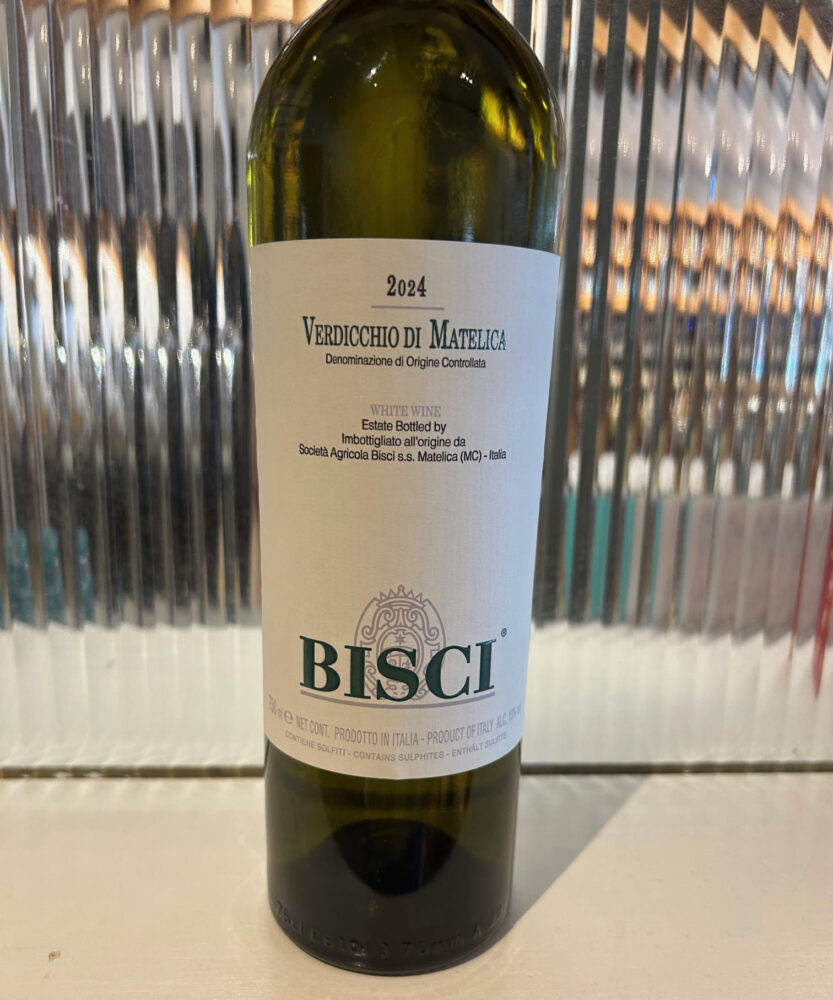
Le Marche, between Umbria and the Adriatic Sea, is five times longer than it is wide. Matelica enjoys a distinctive microclimate of ample sunlight, constant breezes and dry nights due to its setting in the Alta Valle dell’ Escino, the only valley in Le Marche that lies parallel to the Adriatic Sea, nestled between the Natural Park Monte San Vicino and the towering Sibillini Mountains.

Bisci was founded in 1972 and contains 25 hectares, 18 of which are planted with Verdicchio grapes. Bisci is now run by the second generation, brothers Mauro and Tito. 1998 was their first vintage from vines dating from 1978 and in 2019 the first certified organic wines were produced. Their Verdicchio di Matelica’s award winning vintages were 2008, 2011, 2016 and 2019. In 2018, Gambero Rosso chose the Verdicchio di Matelica 2018 as its Tre Bicchieri winner.
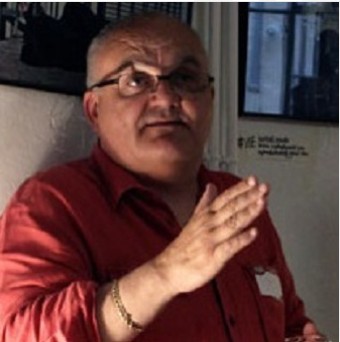
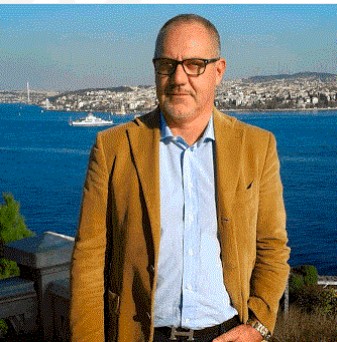
Emily and I tasted this Verdicchio with our rep recently and we liked it for its clear scents of peach and white flowers, fresh taste and good balance, with the bitter note in the finish that is characteristic of this grape. This is a great aperitivo for summer evenings, with Piazza’s Marcona almonds, prosciutto and aged cheeses, or pair it with fish or white meat ntrees.
Come join me Friday from noon to 5:45 or Saturday from noon to 4:45 to taste this fascinating white wine!
Cin Cin!
Jenn
Contributor Jennifer Martella has pursued dual careers in architecture and real estate since she moved to the Eastern Shore in 2004. She has reestablished her architectural practice for residential and commercial projects and is a real estate agent for Meredith Fine Properties. She especially enjoys using her architectural expertise to help buyers envision how they could modify a potential property. Her Italian heritage led her to Piazza Italian Market, where she hosts wine tastings every Friday and Saturday afternoons.
The Spy Newspapers may periodically employ the assistance of artificial intelligence (AI) to enhance the clarity and accuracy of our content.
Pollination, as most of us know, is about reproduction – of fruits, vegetables other plants. But from our self-interested point of view – and that of most of the animals on terra firma – it’s about food. Apples and pears and squash and watermelon (and so much delicious more!). Pollination is responsible for one of every three bites of food.
“So many of our fruits and vegetable species require pollination before they set fruit,” says Christy Wilhelmi, author of High Yield, Small Space Organic Gardening. “So, we need these guys to survive. If the pollinators die, we die. It’s that simple.”
According to a 2016 study by the Xerces Society for Invertebrate Conservation, pollinators have declined by approximately 75% in the past 27 years. Staggering, but potentially reversible.
As the name suggests, pollination is the transfer of pollen (male) to the female part of a plant. (This is the sex part for those not paying attention). Many plants need more than one visit to a blossom for good pollination. For example, a female zucchini blossom needs about five visits for a single good fruit to develop. Many plants will not produce fruit without pollination from other plants, but even self-pollinated plants benefit from pollinators. A recent University of Vermont study showed that when birds and bees protect coffee plants (and in the course, pollinate them), the result is bigger and more plentiful beans. Bigger, better crop; bigger, better income for growers; more for us grateful caffeinators.
According to the National Park Service, three-quarters of all the flowering plants on earth are pollinated by insects and animals. Of course, we could possibly do it ourselves as China has been forced to do. In Sichuan Province, pesticides and pollution have so decimated the pollinator population there that orchardists must hand-pollinate fruit trees. It’s a painstaking process that needs to be repeated as many as five times per blossom to ensure marketable fruit.
We might do it all ourselves, but why? It’s designed to work efficiently without our intervention. So, if we restore what the pollinators need, it can run on autopilot while we eat caprese salad and grilled chicken with mango salsa.
Pollination is one of the key ecological services provided gratis in an intricately orchestrated regenerative system that also helps stabilize our soils, clean our air, supply oxygen, and support wildlife. Virtually everything in life multitasks.
“The pollinators might be catching prey to provision their nests or feed their larvae, and as adults they are going to flowers to feed themselves, so in that they are transferring pollen around from plant to plant,” says naturalist Nancy Lawson, author of Wildscapes. “And many are decomposers, who are helping to break down wood and other organic matter. Dead animals and other insects who have died would be piling up all around us without these decomposers.”
So, who is a pollinator? We often think primarily of honeybees, who get lots of press – especially since there have been two overturned tractor trailers of them recently.
“Honeybees are not native, but they are such fascinating, self-directed creatures,” says Wilmelmi, who is also a beekeeper. “They run a democracy within their colony, and they are so hardworking.”
Honeybees are interesting to non-beekeepers, too, because in addition to the amazing intricacy of their lives, we realize that the pollination of almonds and other food trees is currently dependent on professional beekeepers hauling thousands of hives around the country in semis. It’s not hand-pollinating, but it is a necessary pollination industry run by human beings. Yet the original arrangement is more complex – and yet so much simpler, less work for us. And cheaper.
A pollinator is anything that helps carry pollen from the male part of the flower to the female part of the same or another flower. Bees of all kinds, (yes, even annoying carpenter bees), butterflies, moths, flies, bugs, beetles, thrips, and wasps. Also, birds and mammals – for example, opossums, who also eat ticks.
“Pollinators come in many forms,” explains Lawson “They’re beetles and flies and wasps, especially. There are so many solitary wasps that people don’t realize are not threatening to us, and they’re all out there pollinating flowers and being natural insect control.”
While we can see the various flying pollinators during the day, the process continues mostly unseen at night.
“Bats not only hoover a thousand mosquitoes out of the sky every night,
but they are nighttime pollinators of cactus, succulents, and tropical fruits like mangos and bananas,” Wilhelmi says.
“Ethiopian wolves pollinate Red Hot Pokers (Kniphofia),” notes Lawson. “They lick the flower, and the pictures of them with pollen all over their faces makes me wonder what other pollinators we just don’t know about [yet].”
So, how can each of us help? Restore habitat for one thing. Just as we need fueling stations and places to sleep on a cross-country road trip, pollinators of all kinds need well-supplied way stations in addition to established communities.
“People already know they should be planting native flowers that native bees and other animals have evolved with,” says Lawson. “They also need to think about massing the same plants, so pollinators pick up on these visual and olfactory signals and cues. If you only have one or two, it won’t have much for many creatures, but start with five near each other and let them spread. And plant really fragrant flowers like native Clematis (Clematis virginiana) and the trees and shrubs – Black Cherry (Prunus serotina), Mountain Mint (Pycnanthemum), Woodland Phlox (Phlox divericota), native roses, Carolina Rose (Rosa carolina) – because scent is really important to bees and other pollinators to help them locate what they need.”
Another key thing is to reduce or eliminate pesticides, (another cost-saving). Then let the good times roll. Once you’ve got a good mix of symbiotically living things, the whole system tends to take care of itself. The result is both productive and fascinating. Discovery channel in your own backyard.
RESOURCES:
https://www.pollinator.org/pollinators
https://www.humanegardener.com/humane-gardening-tenets/
https://www.uvm.edu/gund/news/secret-better-coffee-birds-and-bees
https://www.xerces.org/pollinator-conservation/whats-at-stake
https://extension.umd.edu/resources/#!/category/2/subcategory/68
High Yield, Small Space Organic Gardening by Christy Wilhelmi (Creative Homeowner, 2025
Wildscape: Trilling Chipmunks, Beckoning Blooms, Salty Butterflies, and other Sensory Wonders of Nature by Nancy Lawson (Princeton Architectural Press)
Longtime journalist and essayist Nancy Taylor Robson is also the author of four books: Woman in The Wheelhouse; award-winning Course of the Waterman; A Love Like No Other: Abigail and John Adams, a Modern Love Story; and OK Now What? A Caregiver’s Guide to What Matters, which she wrote with Sue Collins, RN.
The Spy Newspapers may periodically employ the assistance of artificial intelligence (AI) to enhance the clarity and accuracy of our content.


The Spy Newspapers may periodically employ the assistance of artificial intelligence (AI) to enhance the clarity and accuracy of our content.
Ciao Tutti!
This weekend at Piazza Italian Market,we will taste a new wine to our collection, the La Lupinella Superiore DOCG ($21.50, 13.5 ABV) from the Bitossi Winery’s Sant’ Ansano vineyard in Toscana. This wine area contains the Montalbano Hills and has long enjoyed a reputation for producing great wine that led to its being recognized as early as 1796 as a prestigious wine area. “Lupinella” is named for a local wildflower and the eye-catching label was designed by an American artist, Don Carney. The “Lupa” (wolf) image pays homage to . the legendary she wolf. In Roman mythology, she rescued the twins Romulus and Remus who were abandoned in the Tiber River and nursed them until a shepherd found and raised them. The twins grew up to found the city of Rome.

La Lupinella Superiore DOCG ($21.50, 13.5 ABV) from the Bitossi Winery’s Sant’ Ansano vineyard in Toscana
The Bitossi family has been in Toscana since the 16th century where they first became renowned ceramic artisans. The clay soil of their land is the common denominator of both the raw material that is spun to create their ceramics and the amphoras in which their wines are now made. Artist Don Carney also designed several tile patterns for the family. I have several pieces of Italian ceramics so I was fascinated to learn that since the early 1920’s, some of the most important Italian and international designers such as Aldo Londi and Ettore Sottsass have collaborated with Bitossi in their laboratories in Montelupo Fiorentino.

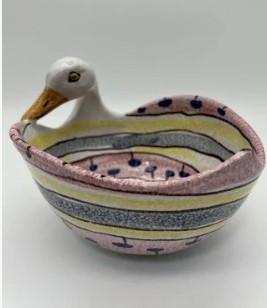
In the late 1970’s,Vittoriano Bitossi acquired parcels of land SW of Florence that would become his vineyards, in the commune of Vinci (birthplace of Leonardo). Like many other winemakers, he began making wine for his family and for local consumption until the mid-1990s when Bitossi sought distributors and importers for their wines.

Today, Owner Marco Bitossi and Winemaker Manuela Marzi work their 10 hectares in Montespertoli and 2 hectares in Sant’Ansano. Their vineyards of Canailolo, Colorino, Sangiovese and Trebbiano are certified organic and their annual production is 2500 cases. Emily and I tasted La Lupinella recently and we liked its aromas of fresh red berries, its medium body, light tannins and long finish. La Lupinella is named “Rossa” for its variety of grapes including Sangiovese (85%),Canaiolo (15%) and Trebbiano (5%).
We thought it was a refreshing take on Sangiovese so come join me on Friday from noon to 5:45 and Saturday from noon to 4:45 to see if you agree!
Cin Cin!
Jenn
Piazza Italian Market is located in the Talbot Town Shopping Center at 218 N. Washington St., suite 23, in Easton, MD.
Contributor Jennifer Martella has pursued dual careers in architecture and real estate since she moved to the Eastern Shore in 2004. She has reestablished her architectural practice for residential and commercial projects and is a real estate agent for Meredith Fine Properties. She especially enjoys using her architectural expertise to help buyers envision how they could modify a potential property. Her Italian heritage led her to Piazza Italian Market, where she hosts wine tastings every Friday and Saturday afternoons.
The Spy Newspapers may periodically employ the assistance of artificial intelligence (AI) to enhance the clarity and accuracy of our content.

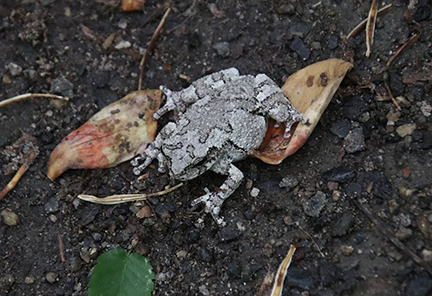
The Spy Newspapers may periodically employ the assistance of artificial intelligence (AI) to enhance the clarity and accuracy of our content.
Ciao Tutti!
This weekend at Piazza Italian Market we will taste a white wine from the Langhe Nas-Cetta del Commune di Novello 2021 ($26.99, 12.5% ABV) from the Azienda Agricola Cogli L’Attimo di Serena Anselma in Piemonte. “Cogli L’Attimo” translates as “seize the moment”, which a fitting phrase for how this wine has made its way to Piazza’s shelves.
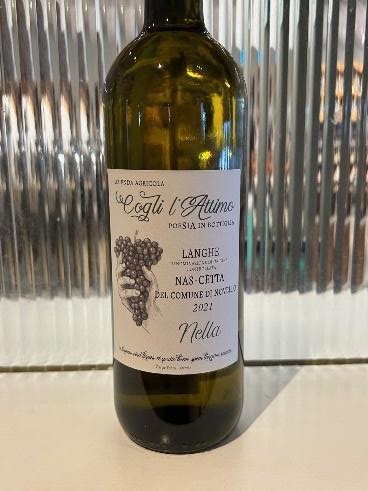
This weekend at Piazza Italian Market we will taste a white wine from the Langhe Nas-Cetta del Commune di Novello 2021 ($26.99, 12.5% ABV) from the Azienda Agricola Cogli L’Attimo di Serena Anselma in Piemonte.
Last year, Emily attended Vinitaly, which is the leading international wine & spirits trade fair for exhibitors, buyers and wine lovers. Emily sought out small scale producers, one of which was Serena Anselma, who asked Emily for advice about breaking into the US market. Emily seized the moment and contacted one of Piazza’s importers, Doria Wines, since they seek out artisanal winemakers. The brother and sister duo of Marco (Torino) and Cristina (DC) seized their moment and Marco visited Serena and now they represent Cogli L’Attimo! The winery is a perfect fit to Doria Wines’ criteria of native grape varieties, sustainable farming, minimal intervention, small scale production and winemakers who are personally involved from planting the vines to bottling.

Serena Anselma
Serena Anselma left her career of teaching languages to fulfill her dream of producing wine from her family’s old vineyards, whose grapes had previously been sold for bulk production. In 2016, she founded her own winery on her grandparents’ land in Novello, one of the eleven municipalities that produce Barolo. Her annual production is small (about 15,000 bottles). Her winery may be less than ten years old, but it is rooted in the beautiful Langhe hills. She works with Sergio Molino, a renowned oenologist, to produce wines that are authentic native varieties since a great wine is dependent upon the quality of the grapes.
Currently, Serena produces Barolo cru Cerviano Merli, Nebbiolo d’Alba, Barbera d’Alba, Dolcetto d’Alba, Nas-cetta and one orange wine. The native grape Nas-cetta almost disappeared, but has a new life thanks to its rediscovery by small producers in the municipality of Novello like Serena and her wine entered the market in 1994. Eight years later, it became part of the Langhe DOC. In 2010, the Langhe Nas-cetta del Comune di Novello DOC designation was created to recognize only one municipality, Novello, for the use of 100% Nas-cetta grapes.

Emily has fond memories of this white wine’s floral and fruity aromas and its vibrant citrus flavor. Pair with fresh seafood or risottos, white meat entrees with lemon and herbs, dishes with asparagus or fennel, goat or feta cheese.
Come seize your moment and join me Friday from noon to 5:45 or Saturday from noon to 4:45 and celebrate this new wine’s debut at Piazza!
Cin Cin,
Jenn
Piazza Italian Market is located in the Talbot Town Shopping Center, suite 23, in Easton, MD
Contributor Jennifer Martella has pursued dual careers in architecture and real estate since she moved to the Eastern Shore in 2004. She has reestablished her architectural practice for residential and commercial projects and is a real estate agent for Meredith Fine Properties. She especially enjoys using her architectural expertise to help buyers envision how they could modify a potential property. Her Italian heritage led her to Piazza Italian Market, where she hosts wine tastings every Friday and Saturday afternoons.
The Spy Newspapers may periodically employ the assistance of artificial intelligence (AI) to enhance the clarity and accuracy of our content.
Ciao Tutti!
This weekend at Piazza Italian Market we will taste the 2021 Cannonau Capo Ferrato DOC ($15.99, ABV 13.5%) from the Cantina Castiadas winery. Founded in 1959, the winery takes its name from the region in which it is located, in the picturesque southeastern part of Sardinia in the Cannonau di Sardegna DOC denomination. “Capo” translates as cape or promontory and “ferrato” probably refers to the iron rich soils of this region. “Capo Ferrato” also pays homage to the beaches of Capo Ferrato on the Tyrrhenian Sea NE of inland Castiadas.

Cantina Castiadas is considered one of Sardinia’s most esteemed wineries. Its unique location near to both the rugged mountainous landscapes and also the picturesque Costa Rei beaches, results in grapes of exceptional quality, due to their daily optimal solar exposure balanced by cooling breezes from the Tyrrhenian Sea. The vineyards are rooted in clay soils and granitic sands and produce wines of intense minerality from their vinification in stainless steel vats that preserves the cannonau grape’s natural character. Always present is the fragrance of the macchia, the ubiquitous low ground cover found all over the island. ( If you are a fan as I am, of Daniel Silva’s books, one of the protagonists makes regular visits to a retired Mafioso for advice and during his drive, he savors the macchia’s fragrance on his way the Mafioso’s compound).

Cantina Castiadas now has 115 hectares containing 14 grape varieties. The Capo Ferrato Cannonau is full bodied, 100% Cannonau grape, with ripe raspberry and strawberry aromas, and delicate floral notes with well balanced tannins and a long velvety finish. The bonus is the wine contains three times the amounts of anti-oxidants, compared to other red wines, resulting in cardiovascular benefits almost ten times higher than varieties of grapes from other areas of Italy. The cannonau grape was featured in Netflix’s feature “Live to 100: Secrets of the Blue Zones”.
Pair the Capo Ferrato Cannonau with hearty dishes of roasted lamb, grilled veggies, Piazza’s aged cheeses or pasta with rich tomato sauces and spicy sausages. For those of you who have tasted our current Pala Cannonau, come join me Friday from noon to 5:45 or Saturday from noon to 4:45 to compare tastes. If you haven’t tried wines from Cannonau grapes, come taste and start your “Live to 100” journey.
Cin Cin,
Jenn
Piazza Italian Market is located in the Talbot Town Shopping Center at 218 N. Washington St., suite 23, in Easton, MD
Contributor Jennifer Martella has pursued dual careers in architecture and real estate since she moved to the Eastern Shore in 2004. She has reestablished her architectural practice for residential and commercial projects and is a real estate agent for Meredith Fine Properties. She especially enjoys using her architectural expertise to help buyers envision how they could modify a potential property. Her Italian heritage led her to Piazza Italian Market, where she hosts wine tastings every Friday and Saturday afternoons.
The Spy Newspapers may periodically employ the assistance of artificial intelligence (AI) to enhance the clarity and accuracy of our content.
Ciao Tutti!
This week at Piazza Italian Market, we will taste the Rosato Toscano IGT ( $19.95, 12% ABV) from the Istine winery in Radda in Chianti, Toscana. Production of Rosato began in Italy many centuries ago, but the Rosato style wasn’t typical in Italy as France’s counterpart in Provence until a sea shift in the early 1900s. Winemakers discovered during their production of red wine that if they reduced the ratio of skin to juice, some of the just-crushed dark shinned grapes bled away. This runoff was then fermented separately to produce a simple Rosato. Soon, growers made wine from grape varieties explicitly grown to become deeply flavored Rosati.
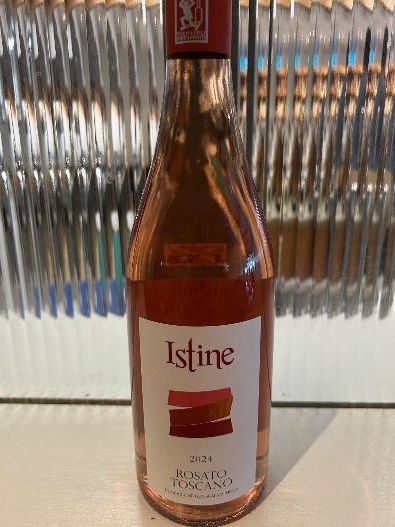
Rosato Toscano IGT ( $19.95, 12% ABV) from the Istine winery in Radda in Chianti, Toscana.
Istine’s high-altitude, small vineyards are located in Radda in Chianti and Gaiole in Chianti in the Chianti Classico area. Winemaker Angela Fronti’s family was originally engaged in the construction and management of vineyards and grew grapes previously sold in bulk.
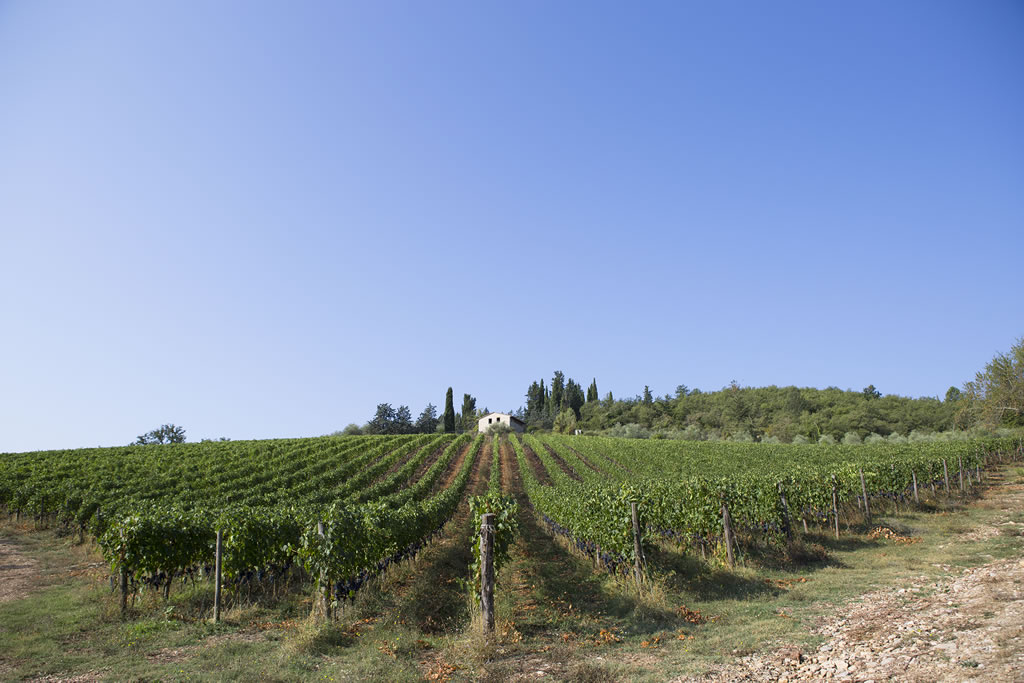
When you have three vineyards in the heart of the Chianti Classico region, in high locations having soils in which the Sangiovese grape of Chianti Classico thrives, it is time to get into the game. Fonti took a leap of faith and in 2009 launched her first wines. She became a rising star in Chianti wine and seven years later, the winery was certified organic. Her portfolio of wines now includes ten wines and spirits, including Rosato, Bianco, Merlot, five Chianti Classico, and Reserva; Gin, and Vermouth.
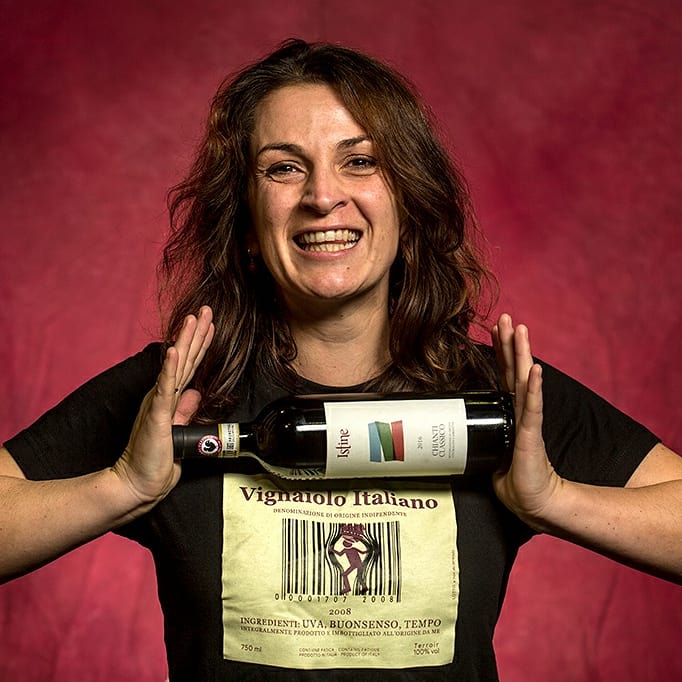
Fronti is also a member of the FIVI (The Italian Federation of Independent Winemakers), founded in 2008. The distinctive decal on the neck of bottles signifies the winemaker cultivates his/her own vineyards and bottles and sells his/her own wine as an extra indication of quality.

Istine Rosato is made from 100% Sangiovese grapes. It has a deep pink color, a lush nose of ripe red fruit aromas, bright acidity, and a mineral-driven finish. It is very easy to drink as an aperitif or to pair with grilled fish or veggies.
Many of you are fans of this winery’s Chianti that is currently in Piazza’s collection so come join me on Friday from noon to 5:45 or Saturday from noon to 4:45 to taste Chianti’s cousin Rosato!
Cin Cin!
Jenn
Piazza Italian Market is located in the Talbot Town Shopping Center at 218 N. Washington St., suite 23, in Easton, MD.
Contributor Jennifer Martella has pursued dual careers in architecture and real estate since she moved to the Eastern Shore in 2004. She has reestablished her architectural practice for residential and commercial projects and is a real estate agent for Meredith Fine Properties. She especially enjoys using her architectural expertise to help buyers envision how they could modify a potential property. Her Italian heritage led her to Piazza Italian Market, where she hosts wine tastings every Friday and Saturday afternoons.
The Spy Newspapers may periodically employ the assistance of artificial intelligence (AI) to enhance the clarity and accuracy of our content.
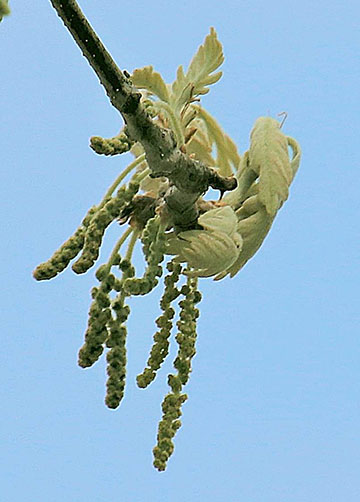
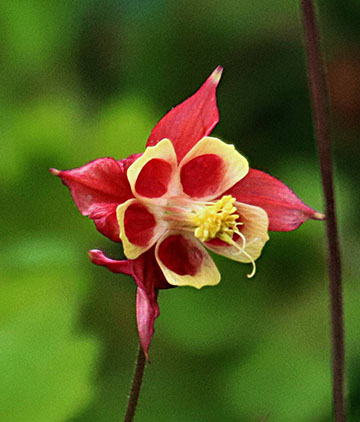 .
.The Spy Newspapers may periodically employ the assistance of artificial intelligence (AI) to enhance the clarity and accuracy of our content.